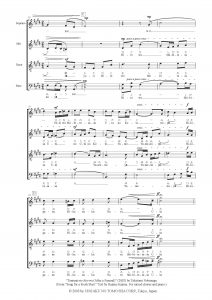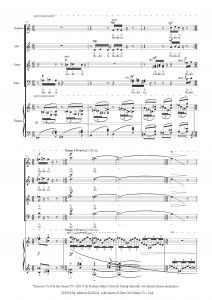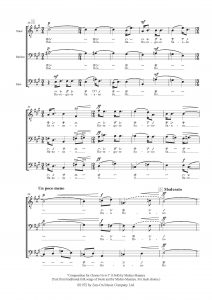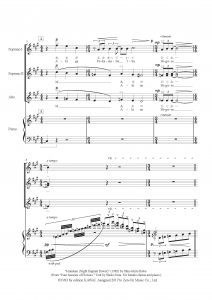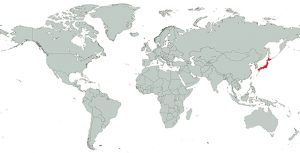 From Songbook: A Series of Choral Masterpieces published by Japan Choral Association
From Songbook: A Series of Choral Masterpieces published by Japan Choral Association
Akihiro Kanagawa, Representing International Committee, Japan Choral Association
Japan Choral Association (JCA)[1], consisting of 4,470 Japanese choirs (as of January 2020), has been holding the National Choral Competition every year since 1948. This is a national event in which mixed, female, and male choirs of all generations, from primary school students to adults, take part in regional competitions (1,484 choirs participated in 2019), and only the groups that qualify in the prefectural/regional rounds can proceed to perform in the national competition[2].
The choirs are required to sing a compulsory piece at the competition. Every year, JCA selects four choral pieces for each category (mixed, male, and female chorus – 12 pieces in total), considering the diversity of the choirs’ structures and preferences, and compiles them into an anthology published as Songbook: A Series of Choral Masterpieces. The participating choirs can choose a song from the four pieces for their applicable category.
This anthology contains a good balance of both Western choral music – from Renaissance polyphony to modern masterpieces – and Japanese choral music, although unfortunately only recent and modern music exist. Japanese pieces include music by the leading composers of the past and today, along with works by young composers who will lead the next generation (see Tables 1 and 2). Why is this possible? The secret is the Asahi Choral Composition Prize.
With the aim of creating and promoting excellent Japanese choral music, JCA started an annual open contest of choral compositions in 1971. Since 1979, it has become a rule to adopt the winning piece as a compulsory piece in the National Choral Competition. Then, in 1990, the Asahi Choral Composition Prize (prize money: 1 million yen (approx. US $10,000)) was newly created as an official award for the contest. With this prize, the quality and quantity of the submitted works improved remarkably, and the winning composers started to receive significant recognition by society. If the choral world is like a forest, we are planting young trees looking ahead to 30 years or 50 years from now. The fully grown forests will store water, produce nutrition, and nurture rich lives for years to come.
Let me introduce six Japanese choral works (two each for mixed/male/female choirs) selected in the Songbook recently.
Tomurai-no Ato-wa (After a Funeral) (2002) by Takatomi Nobunaga
(From Song for a Fresh Start. Text by Hajime Kijima. For mixed chorus and piano.)
Takatomi Nobunaga is such a prolific and talented composer that it chills me even to imagine what the choral world would have looked like if this composer had not appeared. His career is worthy of special attention , as he graduated from university without majoring in music. It is also surprising that he acquired his piano and composition skills almost by himself.
As it has been three-quarters of a century since Japan experienced the war, most Japanese citizens are “children who do not know the war.” Even though Nobunaga is right in the midst of this generation, it is noteworthy that many of his messages are about the unreasonable nature of war. The composer himself wrote that his motive for creating the piece was a prayer which resonated with him written by Hajime Kijima, a poet who looked for a ray of hope even in despair, based on his primal experience of, “going through the aftermath of war while caring for A-bomb victims at the age of 17.”
Of special importance is the last verse, “More paralysing than a gun / A tune that stops you from pulling the trigger,” with a strong air of agonising pain at having no choice but to believe in a transient existence. The piece is written very simply without unusual harmony or techniques. This simplicity is the very beauty of this music. If anything, the extremely slow tempo of ♩ = 33 leaves you with a stronger impression of this deep prayer in Japanese.
Takatomi Nobunaga (1971- ) The most frequently performed current choral composer in Japan, having created works for mixed, male, and female choruses, including arrangements favoured by many. Three-times winner of the Asahi Choral Composition Prize (1994, 1995 and 1999). Became a professional composer after a previous career as a government official, having acquired composition skills through self-learning.
Kusa-no Ue (On the Grass) IV (2017) by Kentaro Shuto
(Text by Tatsuji Miyoshi. For mixed chorus and piano.)
The winning piece of the Asahi Composition Prize in 2017. It is the last piece of a suite for mixed chorus and piano entitled On the Grass (five pieces), but it is titled “IV” because the first piece of the suite is a piano solo prelude . The texts are a series of four verses taken from Sokuryo-sen (Survey Ship) (1930), a feature work by one of the best Japanese poets, Tatsuji Miyoshi (1900-1964).
The pianist must be considerably skilled to be able to perform this music. As a background, piano education is highly advanced in Japan, but there is also a strong intention by the composer to incorporate styles of musical instruments into vocal works.
Conductors from other countries often ask me why there are few a cappella choral works in Japan. A major reason is that chorus experiences for most people start in school education in Japan, while they are rooted in churches in other countries. School teachers always use keyboard instruments for teaching and the singers tend to depend on them, so they find it natural to play with accompanying instruments.
This piece has a weak sense of tonality in the right-hand part of the piano, but the left hand plays perfect intervals, so it may be easier to sing for the chorus than it seems on the score. A goose is dashing down a path and on the grass in a flurry. Probably it is a sunny day with clear sky. Her shadow is also running along in a flurry. This rush and the humour are described well, especially by the piano. The glissando played by the piano’s right hand may be a scene where the goose opens its wings. This lively presence is expressed as if we can actually hear its quack, with the comical ending of splashing into the pond expressed with a tone cluster.
Kentaro Shuto (1985- ) Winner of the Asahi Choral Composition Prize in 2017. Composer/Arranger, also active as a pianist, instructor, YouTube creator and sound producer. Graduated from Tokyo University of Arts (Composition Department, Faculty of Music). Master’s degree from Tokyo University of Arts, Graduate School of Music.
Composition for Chorus No 6-I (1968) by Michio Mamiya
(Text from traditional folk songs of Iwate and by Michio Mamiya. For male chorus.)
Michio Mamiya was among the first Japanese composers whose works were performed and favoured by choirs outside of Japan. He may resemble Bartók or Kodály of Hungary in that he incorporated traditional folk music into his creations. The fact that he travelled all over Japan for field research into traditional tunes and tried to analyse and classify relationships between the lyrics and music as well as between text and rhythm was probably an influence from the two Hungarian composers.
In the process, he realised the richness of Hayashi-kotoba (meaningless words for rhythmical effect), which is added to almost every Japanese traditional folk song. The title of ‘Composition’ was born in the process of classifying and structuring these words for sound effect.
Composition No. 6 consists of three movements, the first of which was selected as a compulsory piece. It was based on two folk songs maintained in Waga County and Hienuki County (currently Ohasama Town, Hanamaki City) in Iwate Prefecture. The first half is Hie-tsuki Uta (Millet-Pounding Song) sung in Waga County. Japanese millets and foxtail millets are minor grains used in lieu of rice, and they were precious food in this region, which frequently suffered from famine due to cold weather in the past. This is a work song sung by two or three people surrounding a hand mill while pounding the grain. In the lyrics, tenant farmers are cursing their master for being flattering while they are working but treating them coldly once the work is done.
The motif for the latter half of the piece is Hayashi-kotoba (rhythmical meaningless words) from Kakitauchi-Uta (Rice Planting Song), a rice-planting dance song maintained in Kamegamori, Ohasama Town. Mamiya’s characteristic fugato is inserted in the middle part of the homophony. It is surprising how he can convert Japanese music, which is originally monophonic, into such a rich sound space.
Michio Mamiya (1929- ) Composer known for 17 works of “Composition for Chorus,” a series of choral pieces using Hayashi-kotoba (meaningless traditional texts for rhythmical effect) as a motif. After carrying out extensive research for many years on traditional folk music of different ethnic groups around the world, including Japan, Mamiya found his interest in these rhythmical words used for sound effect in traditional folk songs and composed this series. Graduated from Tokyo School of Music (now Tokyo University of Arts).
Majime-na Kaotsuki (Serious Countenance) (1979) by Akira Miyoshi
(From Klee’s Picture Book, Vol. 2. Text by Shuntaro Tanikawa. For male chorus.)
The influence of composer Akira Miyoshi on Japanese choral music is unfathomable. It is no exaggeration to say that the Miyoshi school has maintained the chorus culture ever since his death in 2013. The foundation for his music style was the tradition of Western European music. In other words, it was a product of untiring admiration commonly held by musicians born in the Far East.
The poem was originally published by Shuntaro Tanikawa as For ‘Picture Book’ of Paul Klee’s Pictures in 1975. Tanikawa says that he wrote these poems inspired by the titles of the pictures, rather than Klee’s paintings themselves.
Majime-na Kaotsuki (Serious Countenance) is written with clear tonality (G) and is considered relatively easy for solfege, which was why it was chosen as a compulsory piece. The texts consist of four verses of three lines, and the ending, “Serious people / Kill people seriously / Terrifying,” is the core of the piece. The harmony procession of this part has an eeriness typical of Miyoshi and is overwhelming.
As Miyoshi uses many soft accents to change the sound colour, the description of < > is called “Miyoshi accent” in Japan and is sometimes considered special. Klee’s colours are musical, and Miyoshi’s music is very colourful.
Akira Miyoshi (1933-2013) Composer of plenty of choral works as well as music for orchestras, chamber music and songs. His music-making style and use of harmonies have significantly influenced composers of the next generation, especially in the choral field. Miyoshi studied at the Conservatoire National Supérieur de Musique in Paris on a scholarship provided by the French government while he was a student at Tokyo University (Department of French Literature, Faculty of Literature).
Kasuga-Taisha Otaue-Uta (Rice Planting Song of Kasuga-Taisha Shrine) (1983) by Hideki Chihara
(From Two Rice-Planting Songs. Text by Hideki Chihara based on traditional songs. For female chorus.)
Hideki Chihara is among the most popular composers of today. His works are especially favoured by young choirs.
There is a Japanese word, Keren (showiness), which is a term used in theatrical drama and means playing to the gallery as a directing method. Simply put, it is a way of exaggerated expression, perhaps similar to “déformer” in French. While Noh is quiet, Kabuki and Joruri are active, and this activeness is the showiness. Hideki Chihara’s works are filled with this Keren-mi (showmanship).
Kasuga-Taisha is one of the most historical shrines established at the foot of Mount Kasuga in Nara – a former capital of Japan – in 768 A.D. The motif of this song is a religious ritual held at this shrine every January, with a dance offered to wish for a rich annual harvest at the rice-planting festival. The accompaniment is a style of music originally brought over from China called Gagaku (ceremonial court music) and has a unique sound based on a twelve-tone scale – almost a chromatic scale, but slightly different from equal temperament. If you play the first motif at the beginning of the piece, you may feel this more or less.
The original song has the quietness of Noh, but Chihara has rewritten it into cheerful and free-spirited active expression typical for work songs, as if we can see the fair legs of young girls beneath their underskirts as they plant rice.
The composer’s intention is to remove the barriers between sacred and secular, artistic songs and folk songs.
Hideki Chihara (1957- ) Composer with a unique style of combining Japanese traditional music, classical literature, folk songs and traditional arts with Western music such as Christian sacred songs. Graduated from Tokyo University of Arts (Composition Department, Faculty of Music). Master’s degree from Tokyo University of Arts, Graduate School of Music. Having been taught composition by Michio Mamiya, Chihara has won various prizes in composition contests in Japan and other countries since he was at university.
Ieraishan (Night Fragrant Flower) (1982) by Shin-ichiro Ikebe
(From Four Seasons of Flowers. Text by Shoko Ema. For female chorus and piano.)
Shin-ichiro Ikebe is a composer considered to be among the first students of the Miyoshi school. He is an all-round composer who writes all genres of music, but he has no equal in incidental music for theatrical dramas and films.
Regarding involvement in society as important, he has created many works on the theme of environmental issues or human rights. He assumes many public roles, and his active creativity is unstoppable even after reaching 77 years of age. He is also an advisor to JCA.
Ieraishan (Night Fragrant Flower (L. telosma cordata)), selected as a compulsory piece, is a work for female chorus with piano accompaniment. The title is the name of a flower native to southern China or Vietnam. Its yellow flowers with five petals bloom in the summer with floating sweet incense, but the incense somehow deepens at night, which is the origin of the name.
This poem is set in the Autumn section of a collection of poems by Shoko Ema and botanical arts by Junzo Fujishima, titled Four Seasons of Flowers, and the music is written in a classical style to cherish the beauties of nature, which is unusual for Ikebe’s works. Shoko Ema is the poet of Natsu-no-Omoide (Memories of Summer) by Yoshinao Nakata, a song known by all Japanese people. While she thought of Oze – a highland marsh on the border of Fukushima, Niigata, and Gunma prefectures – at the scent of Mizubasho (skunk-cabbage flowers) in Natsu-no-Omoide, here she is dreaming of different countries faraway. Ikebe expresses the deepening air of autumn with the humming in the parts without lyrics.
Shin-ichiro Ikebe (1943- ) Composer of a variety of music for chorus, orchestra, film and television, Shin-ichiro Ikebe is a forerunner of Japanese modern music. Graduated from Tokyo University of Arts (Composition Department, Faculty of Music). Master’s degree from Tokyo University of Arts, Graduate School of Music. Taught composition by Akira Miyoshi at university. Advisor to JCA, Professor Emeritus of Tokyo College of Music, and holds titles at many cultural organisations.
Translated by Tomoko Yokoyama (International Committee, JCA)
Edited by Shuhei Sanada (JCA Secretariat) and Lydia de Montfort
Want to sing these songs? Publication information:
Tomurai-no Ato-wa (After a Funeral) (From Song for a Fresh Start. For mixed chorus and piano.)
Publisher: Ongaku No Tomo Sha
ISBN: 978-4-2765-4492-5
Kusa-no Ue (On the Grass) IV (For mixed chorus and piano.)
Publisher: Edition KAWAI
ISBN: 978-4-7609-1985-7
Composition for Chorus No 6-I (For male chorus.)
Publisher: Zen-On Music
ISBN: 978-4-1171-8560-7
Majime-na Kaotsuki (Serious Countenance) (From ‘Klee’s Picture Book, Vol. 2.’ For male chorus.)
Publisher: Edition KAWAI
ISBN: 978-4-7609-1804-1
Kasuga-Taisha Otaue-Uta (Rice Planting Song of Kasuga-Taisha Shrine) (From Two Rice-Planting Songs. For female chorus)
Publisher: Zen-On Music
ISBN: 978-4-1171-9152-3
Ieraishan (Night fragrant flower) (From Four Seasons of Flowers. For female chorus and piano.)
Publisher: Edition KAWAI
ISBN: No data
Edited by Lydia de Montfort, UK
[1] Japan Choral Association: Founded in 1948 and one of the founding members of IFCM, Japan Choral Association, as its name implies, is the largest organisation within Japan’s choral world and the sole organisation to have been granted the long-desired status of a legal corporation in 1970. JCA celebrated its 70th anniversary in 2017. Branches: 9 Regional Associations. Regular members: 54 Prefectural Associations. Support members: 397 persons/organisations. Member choirs: 4,470 (as of 1st June 2020)
[2] JCA National Choral Competition: The competition is organised into the following categories: elementary school choirs; junior high school choirs; senior high school choirs; youth choirs; chamber choirs; equal choirs (male and female), and mixed choirs. The choirs that have won in their prefectural and regional competitions move on to participate in this national competition, which takes place every autumn. The first national competition was held in 1948. Choirs participating in 2019: Elementary school: 39; Junior high school: 607; Senior high school: 497; University/Youth: 80; Chamber: 139; Equal: 70; Mixed: 91. Total: 1,484




